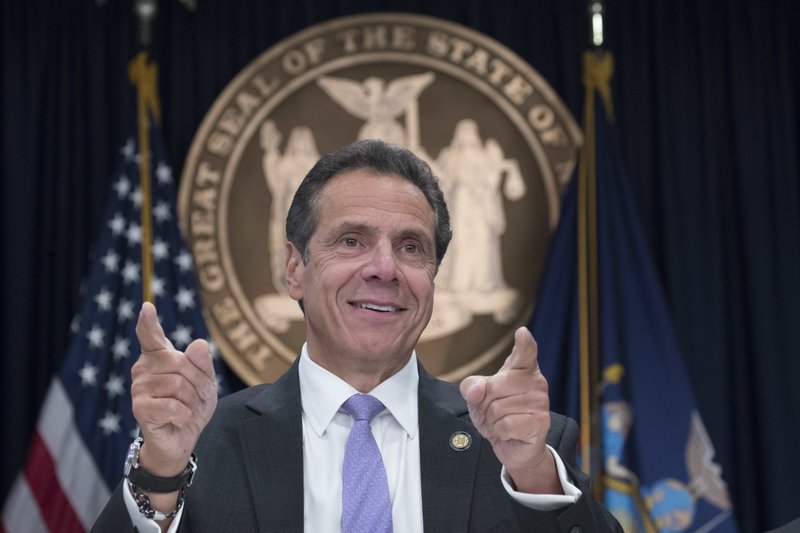In a year awash with liberal challengers aiming to retire establishment Democrats, Andrew Cuomo was an obvious target.
A consummate insider, Cuomo is the son of a governor who ran his father’s campaigns and served as a U.S. housing secretary and state attorney general before being elected governor twice. He’s a prodigious fundraiser who rakes in plenty of corporate campaign cash.
Yet Cuomo was able to quash an insurgent primary challenge from Cynthia Nixon on Thursday by packaging the power of the establishment while embracing the positions of his rival — a blueprint that could offer Democrats a path forward as the party looks to confront Republicans and contend with fissures within its own ranks.
Cuomo dismissed the idea that established Democrats are in danger of being tossed out by young, leftist candidates. He called the congressional primaries that produced a surprise victory by Democratic Socialist Alexandria Ocasio-Cortez a “fluke,” and noted he won her district by a large margin.
“I am not a socialist. I am not 25 years old. I am not a newcomer,” Cuomo told reporters Friday in his first public appearance since he skipped his own election night party. “But I am a progressive, and I deliver progressive results.”
Cuomo’s campaign used a largely traditional approach that relied on key voting blocs — minorities in the Bronx, white Catholics on Staten Island, suburban voters on Long Island — to capture two-thirds of the Democratic primary vote. Cuomo marshaled his powerful allies in organized labor and won influential endorsements from mainstream Democrats such as Hillary Clinton and Joe Biden. And he capitalized on his formidable financial advantage, outspending Nixon more than 8 to 1.
At his campaign events, Cuomo touted liberal achievements such as a higher minimum wage, paid family leave, same-sex marriage and gun control. He largely ignored Nixon and instead focused his fire on Republican President Donald Trump, arguing that antipathy toward the president is the one thing that unites all Democrats.
“The fear of Trump is real,” he said Friday.
Cuomo told reporters that he ran the same kind of campaign he always has — one that focuses less on intellectual debates about liberal identity and more on results. Voters, he said, “have real problems and they need real help in life. And they don’t need theoretical and abstract solutions.”
Cuomo successfully defused some of Nixon’s most potent arguments by making them his own. Last year Cuomo called marijuana a “gateway drug”; this year his administration released a report recommending legalization. Last year he signed legislation blocking a plastic bag ban in New York City; this year he proposed a statewide ban.
And by acting on those liberal priorities instead of just campaigning on them, he showed off the power of incumbency while bolstering his argument that he’s a pragmatist who gets things done.
“He took away her issues,” said Baruch College political scientist Doug Muzzio, who said Cuomo had three essential ingredients for victory: money, organization and a message. “All she had was enthusiasm and that isn’t enough. It was the progressive surge meets establishment reality.”
While Cuomo’s strategy worked well in the primary, it could make him more vulnerable in the general election, when he will face Republican Dutchess County Executive Marc Molinaro and former Syracuse Mayor Stephanie Miner, an independent. Cuomo’s opponents have seized on his leftward moves, hoping they cost him support among independents and more conservative voters.
“He’s exposed himself for what he is — someone who will say and do anything” to get elected, Molinaro said Friday.
Cuomo’s victory is similar to recent wins by Delaware Sen. Tom Carper and Rhode Island Gov. Gina Raimondo, who each prevailed this month over liberal primary challengers.
Democrats nationally would be wise to study their victories for tips on how to address growing restlessness within their own party, said Bruce Gyory, a longtime Democratic political consultant who was a senior adviser to former governors Eliot Spitzer and David Paterson.
“The challenge is can you keep both ends of the party together,” Gyory said. “You have to get the energy of the progressives but package it in a way that resonates with suburban voters and in small towns. Cuomo, like Carper and Raimondo, showed they can do both.”
(AP)












2 Responses
Get things done
He might as well have said walk on water and it would mean the same thing
The anti-Trump obsession cost Hillary the election, and it has not done too well for many others. In reality, if Trump can win before having accomplished anything, now that he has accomplished so much, this sentiment will not get too far.
As for his track record, he has done quite little. He managed to bring immorality into the mainstream, essentially legalizing it. This attracts hedonistic voters, and gains popularity, but creates a broken foundation for the system. This government is doomed. He also trashed the Bill of Rights anywhere possible. Sounds good to the ear at first, but it erodes America. I wish him and his ilk speedy retirement.